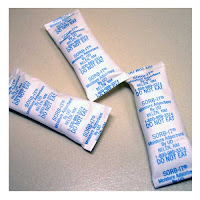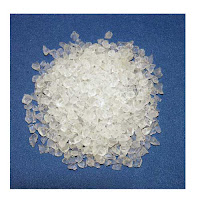Silica and Silicone sound alike!
The other day I got a call from a young woman who wanted to buy a time capsule from us - one of our cylinder styles in the
Future Line time capsule series. At the time, for the "Basic" configuration, we included just a label and either a silica gel or desiccant pack with it. It had no sealant. (Now we include a small sealant with Basic!)
"Do you need to bury it?" I asked. "If so, you'll need to add a silicone sealant kit. It's a few dollars more."
"Yes we are. What I need to know is if the silicone is included with the Basic."
"The Basic includes perhaps the silica gel, but not the silicone sealant," I said.
"What's the difference?"
"Silica gel is a kind of desiccant that dries out the air inside a package, like the little white packets you might see in with a new pair of shoes. Silicone sealant comes in a tube and is like a caulking material - you squeeze it on using the instructions provided, and seal up the capsule for burying or long term placement without peeking."
(We're located in California. It could be even more confusing if we were in the
Silicon Valley instead of the
San Gabriel Valley - home of the
Tournament of Roses Parade,
In-N-Out Burgers' History,
Jet Propulsion Laboratory, and
Big Bang Theory (the show)).
What is the technical difference?
- Silicone rubber is an elastomer - a synthetic polymer - made up of silicone, which in turn is made from silicon, carbon, hydrogen & oxygen. It has the best aging properties of all rubbers, and we prefer it for time capsule sealant use. We sell it as a sealant in a tube of 4 oz or 1 oz amounts. It's easy to apply, is inert, non-corrosive and lasts a long time. Yet, unlike epoxy, it's removable when the time comes to open your time capsule. It also won't crack over time as epoxy and other sealants do. Does your time capsule supplier use silicone rubber gaskets? Ask them. We use a formed silicone rubber gasket or O-ring that fits into a machined groove on our Model 3000 time capsule. Other rubbers simply don't last as long.
- Silicon is an element (Si, 14). It's the 8th most common element in the universe by mass, but you won't find it as a pure free element. You see it distributed in dusts, sands, planetoids & planets as various forms of silicon dioxide (silica) or silicates. It's also used in certain forms for semi-conductors and other sensitive electrical components, hence the Silicon Valley names.
- Silica or Silicon Dioxide is an oxide of silicon with SiO2 as its formula. It's made into many forms, and one is silica gel.
- Silica Gel is most commonly seen in the form of beads inside of a small white packet. In this form, it is used as a desiccant to control local humidity that in turn avoids degradation of goods in storage.
- Desiccants are a hygroscopic substances that induce or sustain a state of dryness (desiccation) in its local vicinity in a moderately well-sealed container. That's good for time capsules! Because of their common use in preservation, it is recommended that the desiccant used be chemically stable or chemically inert, and a number of useful desiccants with this property have been identified and are in common use, such as silica gel and clay-based desiccants.
We sell the
SILICA GEL in 10 gram silica gel packets; we sell the
desiccants in 1/2 unit clay based desiccant, 1 unit clay based desiccant, and 2 unit clay based desiccant packs.
In another blog I will discuss how much silica gel or desiccant to use in your time capsule. Since paper contents have more moisture in them than plastic and metal contents, you will want to use more desiccant inside your time capsule than you might find in a chart for long term storage of machines, plastics, or shoes.
In the meantime, I hope this is a good explanation of the
SILICA GEL vs
SILICONE SEALANT confusion as to names.
Please visit our main website at
Future Packaging and Preservation Time Capsules.


This comment has been removed by the author.
ReplyDeleteThanks for reminding me! Because our main business is time capsules, and those customers don't need to worry about recharging desiccant and silica gel (sometimes for as many as 500 years), I forget to make that more known. I assume also that the container will not leak. Let's talk some more about this. I'll post more detail about how and when to recharge this most useful substance!
ReplyDeleteThis comment has been removed by a blog administrator.
ReplyDeleteSilicone sealant is indeed useful and as such has found popularity (and plenty of shelf space availability) in home improvement stores. I looked at your site just now and did not see much detail among the various sealants you have there, from their descriptions. Maybe more is on each package?
ReplyDeleteOur concern is that the silicone we use and sell MUST HAVE a non-corrosive cure in its manufacturing process. Most of the ones you see in local retail stores have an acetic curing agent. This is fine for household and temporary usage, but over time it tends to degrade or 'outgas'. If it cures inside of a time capsule, for instance, and there are important papers and artifacts inside, we would rather a non-corrosive silicone sealant be used.
Our 82001 sealants are oxime cured, and oxime is non-corrosive. The smaller sealants we provide (82701 & 82703) are also non-corrosive as per the (Permatex brand) package description and characteristics. If you are buying your own sealant for a time capsule, be sure the manufacturer states clearly 'non-corrosive' on the information. One thing though about buying from us - you know WE check to see that it's non-corrosive, PLUS we insert special instructions that allow you to place the sealant onto the time capsule lid area in a way that you can (in the future year of opening) open again without too much destruction to the time capsule. Also included is a TIPS sheet on burying the time capsule.
While we are on the sealant subject, some may think that epoxy and other adhesive products are better, since they are said to be indestructible by the manufacturer. This is not so, and troubles with epoxy fixes to outdoor statues have been found to crack and split over time. The reason for this is simply that the epoxy products do not expand and contract in the way that a sealant does.
For longevity also it's important to note what type of rubber is used as a gasket material. I researched this and found that silicone has the best aging properties, while other rubbers - while they may be stronger and better for some commercial situations - do not age well and therefore we don't recommend them for time capsules.
You would do your customers a service if you could tell them the difference in manufacture among the sealants you sell. Thank you for your comments!
This comment has been removed by a blog administrator.
ReplyDeleteThis comment has been removed by a blog administrator.
ReplyDeleteThis comment has been removed by a blog administrator.
ReplyDeleteWe want to say thnx to you 4 creating this cool weblog and keep going the good work!
ReplyDeleteSilica Gel